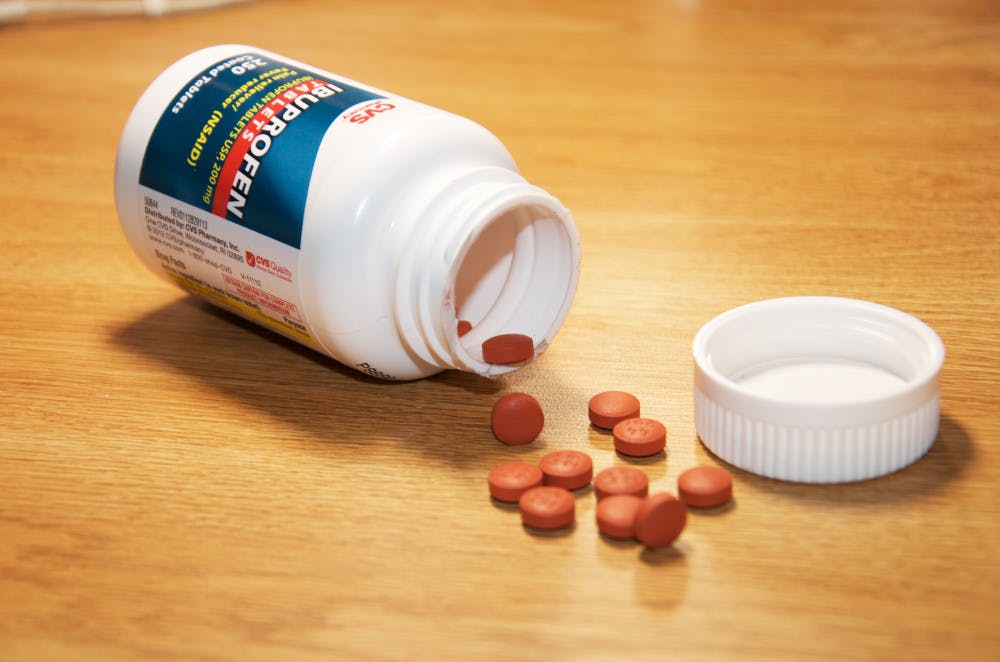Assistant Professor of Emergency Medicine Francesca Beaudoin investigated and compared the effectiveness of various opioid treatments and non-steroidal anti-inflammatory drugs, or NSAIDs, such as ibuprofen, in a study accepted and made accessible online in the journal Pain earlier this month.
Beaudoin and 10 co-authors analyzed a dataset with pain outcomes from 948 patients recorded after they had been injured in car accidents. The study found that the level of pain patients reported after the crash did not statistically differ based on which treatment the patient was prescribed. But those given opioid treatments were more likely to be using them six weeks later.
The study emerged in part from Beaudoin’s work as an emergency room physician and the problems she sees “on a day-to-day basis, both in terms of pain management … and the problems surrounding opioids — specifically misuse, abuse, dependence (and) overdoses,” she said.
Referring to opioids and NSAIDs, she said, “These two medicines that we prescribe most frequently are actually not that well studied and haven’t been compared yet for most conditions.” Specifically in regards to injuries sustained from car accidents, there is not yet sufficient research to indicate which treatment is best, Beaudoin added.
The study was conducted using an observational data set. The data set included pain outcomes of car accident patients six weeks, six months and one year after the original injury, though the initial aim of data collection was not to investigate pain medicines, Beaudoin said.
There were many factors that led to the use of observational data and discouraged implementation of a randomized, controlled experiment, including logistical reasons — such as cost — as well as ethical issues. “There’s some ethical considerations when you’re studying pain and not giving people specific pain treatments,” Beaudoin said.
Using an observational data set, the researchers had to account for various factors that influenced the decision at the provider level regarding which treatment to prescribe, Beaudoin said. “We know that age affects how people report pain, (and) age probably also influences if a doctor gives you an opioid or an NSAID.”
Because the study’s goal was to compare the effectiveness of each drug independent of additional factors, the researchers worked to match cases that were as similar as possible.
“Propensity score matching … tries to make all the characteristics between the opioid group and the NSAID group similar so that the only thing that’s different between the two groups on average is which treatment they got,” Beaudoin said. Ultimately, the researchers were able to match 284 cases directly.
The study indicated that the difference in risk of moderate to severe pain six weeks after a car accident between the two treatment types was not statistically significant. But patients prescribed opioids were 17.5 percent more likely to report continued use at week six.
These results may prompt a reevaluation of current pain management practices, especially in the context of the opioid epidemic occurring across the country. “One of the problems is … not so much the opioid itself, but the fact that people are continuing to use the opioid. It’s pretty addictive,” said Roee Gutman, assistant professor of biostatistics.
Gutman added that opioid addiction may in some cases contribute to other drug abuse issues. “Once the prescription for opioids has stopped, they might try to use heavier drugs, which could lead to other issues.”
The key to addressing this issue may lie in specializing usage of drugs to certain cases. “It might be better to reduce use of those drugs when they’re not really needed,” Gutman said.
“Given the public health crisis with opioids … I think there’s a little bit of a push to figure out what is the most effective pain treatment and who is it most effective for,” Beaudoin said. “I don’t think that with this opioid problem we should throw the baby out with the bathwater.”
Beaudoin also spoke about moving toward individualized medicine. “Some people benefit better from one treatment than the other. It’s not a one-size-fits-all approach,” she said. The study’s co-authors are currently conducting further research on why opioids or NSAIDs are more effective, for which people and in which cases.
While Beaudoin and Gutman both said they do not think this study alone is sufficient to change clinical practice or usage of opioid treatment, they hope that additional research will continue to add to our understanding of pain medication. “Myself and other authors are working to develop a clinical decision aid to determine who would benefit from which treatment — who should get NSAID and who should get opioid,” Beaudoin said.
“You’d think that in 2016 we would know how to treat pain — but there’s not a standard approach to pain management,” Beaudoin said. “With pain, this is still really a work in progress.”





